The crowd roared as a last-second combination landed clean and sent the underdog challenger to the mat for good. The long-standing heavyweight champion fell in shocking fashion.
In the streets outside the arena, even non-boxing fans were celebrating what would become one of the most famous upsets and iconic fights in the history of the sport.
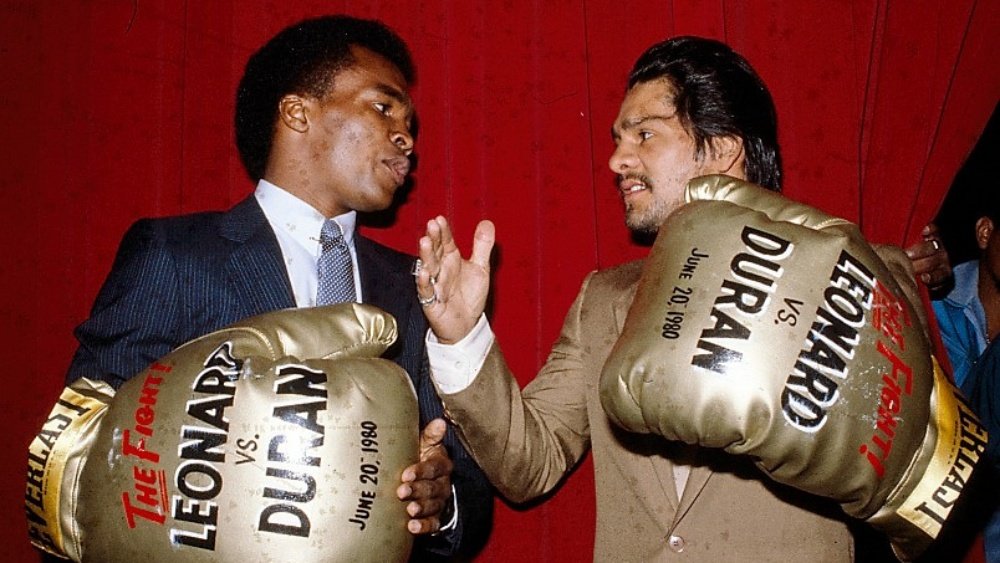
Throughout its long and storied history, boxing has always produced epic battles that captured the public’s attention and defined perceptions of the combatants involved. Rivalries like Ali vs. Frazier and Dempsey vs. Tunney became integral parts of the rich cultural tapestry that makes boxing unique.
This comprehensive guide explores a broad selection of the classic fights and great ring rivalries that every boxing fan should know—the moments that made legends and defined eras in boxing history.
Contents
Early 20th Century Boxing Rivalries
Jack Johnson and the Great White Hopes
At the turn of the 20th century, boxing exploded in popularity and no one was more popular than Jack Johnson. In 1908, he became the first African American heavyweight world champion by defeating Canadian Tommy Burns in Sydney, Australia. This prompted a call to find a “great white hope” to reclaim the championship from Johnson.
Johnson was not well-liked by many white Americans because he unapologetically defied many social customs and racial expectations. As heavyweight champion, Johnson dominated the division over the next six years with his superb defense and accurate, hard punching style.
During this time period, racism prevailed and many whites yearned to see Johnson defeated by a white boxer to restore their belief in racial superiority. Dozens of “White Hope” challengers tried and failed against Johnson.
Finally, former champion Jim Jeffries came out of retirement saying “I feel obligated to the sporting public at least to make an effort to reclaim the heavyweight championship for the white race…
I should step into the ring again.” Jeffries had previously retired as undefeated champion and was seen as the “Great White Hope” with the best chance of reclaiming the title. But in 1910, Johnson soundly defeated Jeffires in 15 rounds in what was deemed “The Battle of the Century”.
Memorable Jack Johnson Matches
| Opponent | Date | Result |
|---|---|---|
| Tommy Burns | 12/26/1908 | Johnson TKO 14 Win/Won World Title |
| Jim Jeffries | 7/4/1910 | Johnson KO 15 Win |
| Jess Willard | 4/5/1915 | Willard KO 26 Loss of World Title |
Finally, American Jess Willard defeated Johnson via a 26th round knockout on April 5, 1915 and regained the world heavyweight championship for the white race to the delight of white supremacists.
Thus ended one of the most racially charged periods in boxing history. Johnson’s dominance and the failure of the “great white hopes” to reclaim the belt until Willard did in 1915 illustrated the inaccuracy of white supremacist beliefs during that time period.
Jack Dempsey vs. Gene Tunney: “The Long Count” Fight
“The Manassa Mauler” Jack Dempsey
Jack Dempsey defined heavyweight boxing in the 1920s with his aggressive, offence-oriented style and brutal punching power. Known for his durability and relentless pressure fighting approach, Dempsey captured the public’s imagination and set records for live event attendance that would stand for over 50 years. His fights with Luis Firpo and Georges Carpentier became cultural events that introduced boxing to millions of Americans.
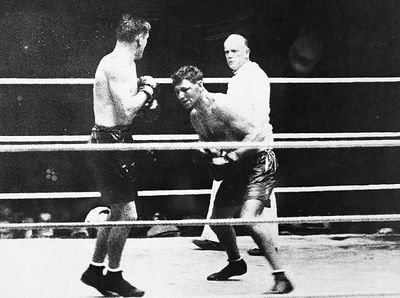
The Skillful Boxer Tunney’s Challenge
However, in 1925 Dempsey had been inactive for three years (serving in the military) when he returned to defend his title against slick-moving, former Marine Gene Tunney in Philadelphia. Tunney was known for his defensive skills, excellent conditioning, and cerebral approach that involved outjabbing and outboxing more aggressive opponents. He was a former light heavyweight champion who had successfully taken on bigger men before.
In front of 120,000 spectators, Tunney frustrated Dempsey with lateral movement and fast jabs, building up a considerable lead on the scorecards going into the final round. Dempsey finally trapped Tunney against the ropes near the end of the fight and unleashed a prolonged barrage of power punches – but the clock expired with Tunney managing to stay on his feet, allowing him to win the decision and snatch away Dempsey’s title.
The competitive clash between boxer vs slugger styles was deemed the “Fight of the Century” and “Battle of the Titans” by the press. Tunney had solved the Dempsey puzzle – but the public demanded an immediate rematch between the sport’s top box office attractions.
The Infamous “Long Count” Rematch
The highly anticipated rematch was held at Soldier Field in Chicago, drawing in a live record crowd of 104,000 spectators who paid a total live gate of $2.65 million despite rain the day of the fight. Unbeknownst to most fans until they arrived, the muddy conditions dictated that temporary wood platforms be installed over the grass field for the ring – drastically slowing the surface for the boxers.
In the 1st round Dempsey again aggressively attacked Tunney, who slipped and fell through the soggy ring ropes. Referee Dave Barry started a mandatory 8-count for a knockdown while corralling Dempsey to a neutral corner.
Tunney actually rose back to his feet in roughly 2 or 3 seconds, but Barry delayed resuming action until around an extra four seconds had elapsed since Tunney was up – thus creating the infamous “Long Count” controversy. Tunney went on control most of the remainder of what would be the final fight in Dempsey’s illustrious career, winning by another 10-round unanimous decision.
Significance of Dempsey vs Tunney
While the mythic quality of the dramatic “Long Count” extended its legacy, Tunney vs Dempsey was about two elite champions with polar opposite styles engaging in two very competitive and skillful matches.
The public split on who deserved to win after the questionable call in the rematch, but Tunney’s victories cemented his place as an intelligent ring general.
Conversely, Dempsey gained almost as much in defeat by showcasing his heart and dangerous punching power for future generations of boxing fans to romanticize. Together, they produced an all-time great rivalry with back-to-back million dollar gates that demonstrated box office appeal the sport had never before seen.
Middle 20th Century Boxing Rivalries
Joe Louis vs Max Schmeling in WWII Proxy Fight
Background Context
In the late 1930s, most of Western society was focused on the impending threat of Nazi Germany and Adolf Hitler’s aggression on Europe. Max Schmeling had achieved German national hero status by becoming their first heavyweight world champion in 1930.
After losing to Jack Sharkey by controversial disqualification, Schmeling earned the label as a capable opponent but generally unchallenging trial horse for up-and-coming contenders.
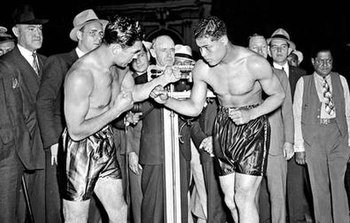
Joe Louis meanwhile had burst onto the scene as a destructive young puncher who appeared destined win the heavyweight crown for himself. With war on the horizon and American patriotic pride riding on him, Louis took on heightened symbolic importance as representing the democratic ideals of the nation against Nazism.
Schmeling’s Upset in First Fight
Surprisingly, the older Schmeling scored a massive upset by knocking Louis out in the 12th round of their initial meeting in 1936 – the first loss of the Brown Bomber’s career.
Schmeling had cleverly studied Louis’ habits and vulnerabilities – in particular his tendency to keep his left lowered after throwing it. This allowed Max to capitalize by countering over Louis’ jab with his famous overhand right cross, which eventually led to the shocking knockout victory.
Hitler and the Nazi party robustly propagandized Schmeling’s achievement as demonstrating Aryan superiority over the Black American Louis in the media. For the 1938 rematch, the showdown now carried far deeper societal implications than just fistic supremacy.
Louis’ 1st Round Destruction of Schmeling in WWII Proxy Fight
With America and much of the Western world solidly behind him, 22 year old Joe Louis stepped into the Yankee Stadium ring on June 22, 1938 with rage and determination simmering inside him for having lost his first fight to Schmeling two years earlier.
The atmosphere was electric with 70,043 emotionally charged fans having filled the massive stadium. As soon as the opening bell rang, Louis charged across the ring, buckling the German’s knees with his first volley.
Schmeling attempted to counter the young champion’s velocities onslaught, but was cornered and overwhelmed by a sustained barrage of accurate power punching until the referee stopped it at 2:04 of round number one.
Significance and Legacy
Coming at the brink of WWII as Hitler seemed poised to take over Europe, Louis’ swift and thorough trouncing of Schmeling in the 1938 rematch was hailed as a triumph of American values against the oppression of the fascist Nazi regime by most media. The symbolic showdown transcended sports in its sociopolitical implications during that dangerous time in world history.
Joe Louis went on to become one of the longest reigning heavyweight champions and an American sports hero credited with helping the country rally against the Axis powers during WWII.
Max Schmeling would ironically go on to risk his own life to save a pair of Jewish children during Nazi Germany’s occupation of Poland. The former rivals became lifelong friends over the years until Louis’ death in 1981.
Their two divergent fights encapsulate one of boxing’s all-time rivalries where the historic context behind the actual matches infused the bouts with such meaning beyond just crowning a single victor in the squared circle.
Muhammad Ali vs. Joe Frazier Trilogy
Contrast of Style and Backgrounds
In one corner stood Muhammad Ali: handsome, brash, verbose, a dancing butterfly who floated effortlessly with speed and flash to back up his bold predictions.
Across the ring was Joe Frazier: blue-collar humble, an industrious brawler molded by farm work who stalked aggressively forward perpetually in his bobbing crouch style, throwing looping bombs. Beyond the obvious clash of ring styles, even the opposites of their backgrounds and personalities fed the contentious rivalry.
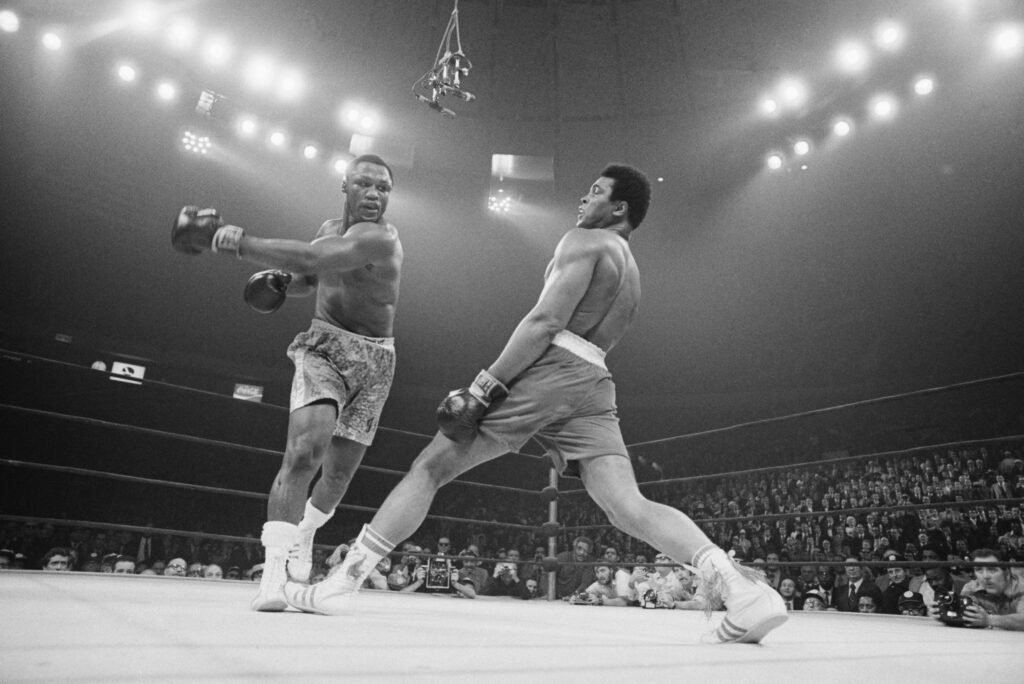
While Ali was banned from boxing during his peak years for resisting the Vietnam draft, Frazier supported his family financially working as a butcher.
He became heavyweight champion during Ali’s forced absence. Ali cruelly painted him as an “Uncle Tom” traitor to his race – in spite of Frazier putting up his Philadelphia gym as collateral to loan Ali money during his suspension. Their bitter feud was deeply personal and transcended boxing.
The Legendary “Fight of the Century” in 1971
After Ali’s return to the ring, the drumbeat steadily built toward their inevitable showdown to unify the splintered titles. Simply dubbed “The Fight of the Century”, Ali vs. Frazier I was the most anticipated boxing match that New York City’s famed Madison Square Garden had ever hosted. It shattered revenue and viewership records, as Frank Sinatra led the way for stars from all facets of culture ringside on March 8, 1971.
True to their divergent styles, Ali danced and lateral moved from his backfoot for most rounds while Frazier bobbed and plodded straight forward – cutting off space and punishing Ali’s body inside in the phone booth exchanges. By the championship rounds, Joe’s relentless pressure began taking its toll as a weary Ali was trapped on the ropes.
In round 15, a legendary slugfest capped the evening with Frazier flooring Ali with his patented left hook to secure a unanimous decision victory. While both men absorbed tremendous punishment, the underdog everyman champion from Philadelphia had beaten “The Greatest” and staked his iconic claim on history in what was deemed an all-time classic.
The Two 1974 Rematches
With unfinished business after such a close and punishing battle, talk inevitably turned to an Ali vs Frazier encore. They met again just three years later, this time in Madison Square Garden where Muhammad Ali hungered to reclaim pole position after losing to Frazier and then Ken Norton during his comeback.
Employing adjusted tactics from their first fight, Ali relied on his jab and lateral footwork to keep the bout at long range – nullifying Frazier’s most dangerous weapon on the inside. Showing superior conditioning in their 12 round non-title bout, Ali piled up points with combinations from distance to gain redemption with a unanimous decision over Smokin’ Joe.
Their heated rivalry justified yet a third and final clash which almost happened immediately in 1974 – this time overseas in Muhammad Ali’s homeland.
The bout was controversially organized by ruthless Filipino dictator, President Ferdinand Marcos, who envisioned the mega fight as a showcase platform for tourism that drew worldwide attention to Manila. Ali again controlled most rounds, and even weathered a hellacious 14th round from Frazier before trainer Eddie Futch stopped it after the corner assessed Frazier’s swollen and closed left eye entering the 15th round.
Legacy of Frazier vs. Ali Battles
While Ali vs Frazier III capped their legendary trilogy, boxing historians and publications generally regard their first 1971 Fight of the Century as the pinnacle peak showdown.
Beyond that initial classic megafight that transcended sports itself, their heavyweight rivalry notably spanned four years across just the three intensely close battles. ESPN ranks it as the greatest set of title fights ever contested.
Each warrior showcased different fighting styles and personalities – but together they produced all-time ring drama that helped carry boxing’s waning popularity out from the shadow of its first golden age.
The timeless appeal of the matchup continues to introduce new generations to the magic and legends of the past. More than just three contrasting fights, their ring rivalry shone light on real socio-political issues of their era involving civil rights, Vietnam, and America’s conscience.
Modern Era Fights and Battles
Sugar Ray Leonard vs. Roberto Duran
Contrast of Styles
By the late 1970s, boxing sorely needed charismatic superstars to replace Ali and Frazier as they faded from prominence. Two contenders arose as perfect foils and captivating stylistic opposites for an iconic rivalry: Sugar Ray Leonard and Roberto Duran.
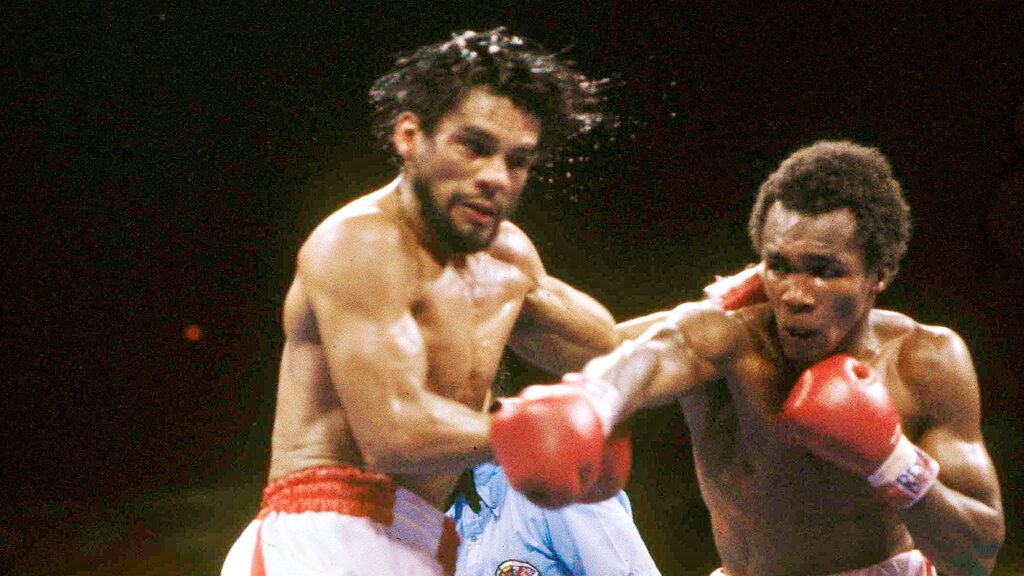
With his big hair, flashy smile, and Olympic gold pedigree, Ray Leonard was the telegenic, perfect package the sport could market to mainstream America.
His blurring hand speed, athletic reflexes, ring generalship ability, and versatile punching combinations made him a rising welterweight sensation. With American corporate sponsors lining up, Leonard appeared destined for stardom and championship glory.
Meanwhile, the force of nature that was “Hands of Stone” Roberto Duran simultaneously bullied his way into title contention.
As a street tough native from the slums of Panama, Duran was all intensity and aggression inside the ring, breaking opponents down with malevolent body punching, winding bolo uppercuts, and malicious mean-mugging. Bob Arum cleverly cast the fighters as the classic boxer vs puncher duel.
Duran Humiliates Sugar Ray in First Bout
They met for the first time on June 20, 1980 in Montreal with Duran’s WBA title and Sugar Ray’s WBC belt on the line. The pandemonium and anticipation at Olympic Stadium encapsulated the magic of boxing on that St. Jean-Baptiste Day.
In what many consider Duran’s finest career performance, his terrifying skill, power, and pressure overwhelmed Sugar Ray as Roberto taunted and punished him relentlessly all night long.
Leonard exhibited heart surviving despite his swollen right eye being nearly closed, but lost by scores of 148–147, 145–144, and 146–144, thus unifying Duran as the undisputed welterweight kingpin.
Sugar Ray Regains Control in “No Más” Bout
Given the competitive and controversial nature of the first slugfest, talk swiftly emerged for the rematch which was booked that November in New Orleans’ Superdome.
This time Sugar Ray Leonard came out cooking from the opening bell, bouncing on his feet while unleashing combination flurries that forced Duran into uncharacteristic retreat early. By the latter rounds, Duran noticeably slowed while Leonard regained confidence – catching the Panamanian with clean shots.
Then suddenly and mysteriously in round 7, Duran turned away from an approaching Leonard and waved a glove while uttering “No mas” to referee Octavio Meyran, resulting in a TKO loss.
Whether Duran surrendered due to stomach cramps, frustration, or simply being outboxed remains debated today. But Sugar Ray Leonard had gained redemption while “No Más” entered boxing lore attached to Duran’s legacy.
The Final 1987 Rubber Match
After the controversy stemming from Duran’s perplexing submission in New Orleans, the mercurial legend embarked on serious comeback attempts to revive his image and entice Leonard into a lucrative rubber match. Duran captured another title which he used as leverage to guarantee the third fight.
They met one final time on December 7, 1987 in Nevada. A tactical boxing match for the most part, Leonard swelled up Duran’s right eye by targeting it while surviving a late round scare after getting wobbled by a big shot from his old rival.
In total command by 12 rounds, Leonard won handily by unanimous decision while exhibiting his superiority despite creeping age. After great financial success together, Leonard would finally retire for good following one more pointless comeback fight as Roberto Duran continued boxing well into his 40s against lesser names.
Mike Tyson Dominance and Up
Tyson’s Spectacular Rise as Youngest Heavyweight Champion
In the mid-1980s, the boxing world witnessed the meteoric rise of a frightening heavyweight wrecking machine named Mike Tyson.
With legendary trainer Cus D’Amato guiding him, the compact and muscular teen created a violent highlight reel of early round knockouts on his way up the ranks. Tyson leveraged frightening hand speed, technique, and explosive power to overwhelm opponents with intimidating force.
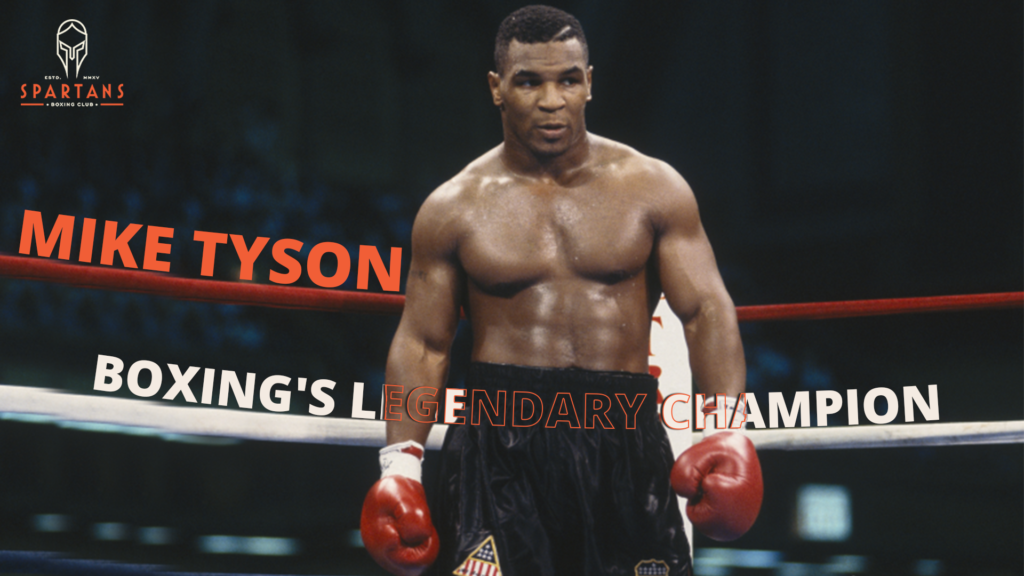
After just two years in the professional ranks, Tyson fulfilled D’Amato’s prophecies by becoming the youngest ever heavyweight champion at age 20 by decimating WBC titleholder Trevor Berbick in 1986.
Over the next few years, Tyson quickly unified all major belts while establishing himself as a global sports superstar renowned for his trademark black trunks and menacing aura.
Buster Douglas Shocks the World
By early 1990, Mike Tyson’s aura of invincibility was at its peak as he prepared to travel to Tokyo to face run-of-the-mill contender James “Buster” Douglas.
The defending champion partied away the training camp, while Douglas rigorously prepared the fight of his career with legendary trainer Angelo Dundee in his corner. Stylistically, Douglas used his 12 inch reach advantage well by pumping the jab while avoiding Tyson’s power shots.
Late in round 8, a clean right uppercut from Douglas sent Tyson to the canvas for the first time in his career. Though he narrowly survived, Mike grew increasingly frustrated and fatigued against Douglas, who dominated the next few rounds.
Early in round 10, a nasty combination punctuated by a final right uppercut deposited Tyson on his back, unable to answer the count. In a monumental upset, Buster Douglas was crowned new heavyweight champion.
Beyond the physical outcome, Douglas represented the first fighter to successfully challenge Mike Tyson mentally and remain unfazed. Conventional boxing wisdom of avoiding Mike’s early power proved flawed as Buster outlasted and broke down arguably the most feared man the sport had ever seen.
Significance on Tyson’s Legacy
While Tyson rebounded nicely at times in following years, the shocking upset loss to Douglas dented Mike’s air of invincibility moving forward. It set a blueprint for more fighters to challenge Tyson’s psyche over an extended fight.
Iron Mike remained a spectacular front runner who could obliterate opponents with speed and power, but the Douglas bout exposed him as human – capable of frustration, fatigue, and defeat against determined opposition.
The stunning loss substantiated old concerns from Cus D’Amato that Tyson lacked the emotional discipline and technical adjustments to adapt in the later rounds of grueling title bouts as his athletic gifts faded.
And indeed history would ultimately come to define Tyson more for losses against Evander Holyfield, Lennox Lewis, and Danny Williams – rather than the explosive young phenom who tore through the heavyweight division unscathed in the 1980s.
Greatest Fights in Recent Years
Ali vs. Frazier of the 90s: Bowe vs. Holyfield Trilogy
As unpredictable and wild as the heavyweight scene became following Tyson’s imprisonment, one intense rivalry emerged from the chaos that evoked memories of the great Ali vs Frazier battles from decades earlier.
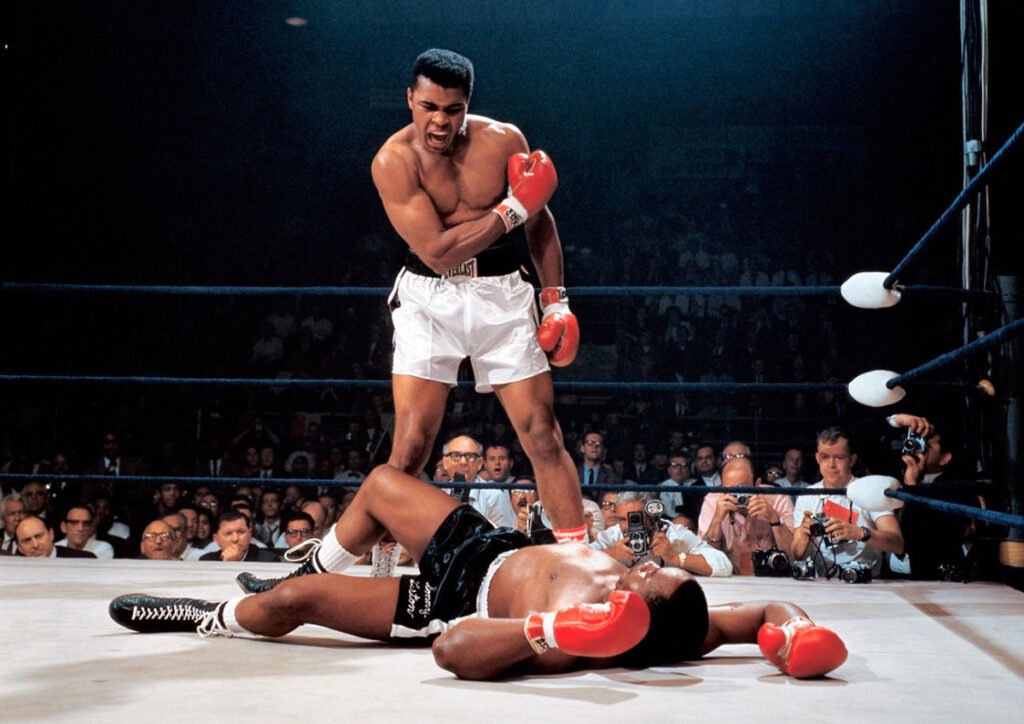
Former Olympic champions Riddick Bowe and Evander Holyfield contested an action-packed trilogy with the undisputed championship at stake each bout.
Though more low key personalities than their bombastic predecessors, this era’s trilogy shared much in common historically with the original including closely contested slugfests, contrasting styles, and continued controversy.
First Fight Goes to Distance
The first meeting between big punchers Bowe and Holyfield took place in 1992. While the anticipated firefight held in bursts, Holyfield’s focus on lateral movement largely stymied Bowe’s offense over the early rounds.
As Bowe’s jabs and combination punching fluctuated, Evander seized momentum with accurate counter shots. Both fighters suffered knockdowns during a thrilling 10th round exchange. Ultimately Holyfield’s superior activity and late push was rewarded with a close majority decision.
The Controversial “Fan Man” Bout
The rematch occurred at Caesar’s Palace with specialty lighting and a wild circus environment. After getting outboxed early, Riddick Bowe surged ahead in the 5th round as his left hooks swelled Holyfield’s eye badly.
Round 7 brought the surreal spectacle of a hang gliding “Fan Man” crashing into the ring and delaying the fight for minutes. The bizarre stunt seemed to swing fortunes as a nicked-up Holyfield roared back and punished Bowe for the remainder.
In round 12 Holyfield had Bowe rocked, but short on time. Once again opinion split sharply with judges scoring unanimously for Bowe while many observers and Holyfield believed he had done enough late amidst the chaos. Beyond crowning an undisputed champion, the bout generated ample controversy and calls for an immediate third fight.
Bowe-Holyfield III Gets Violent
Expectations for fireworks ran high entering the November 1995 rubber match in Las Vegas. And for two rounds the all-offense war delivered as advertised with both fighters giving and taking.
A head clash early in round three opened a ghastly gash above Bowe’s eye, prompting panicked corner confusion and a lengthy delay. Ahead on points, Bowe refused to continue and had to relinquish his title – marking a disappointing anti-climax.
Trilogy Defined as 1990s Version of Ali vs Frazier
With so many parallels in matchups, contrasting personas, bitterly close decision battles, and controversy swirling – Bowe vs Holyfield emerged naturally as the 1990s equivalent to boxing’s most legendary rivalry from the previous era of Ali vs Frazier.
While lacking the bigger than life stars and 1960s political/cultural backdrop surrounding their trilogy, Bowe vs Holyfield deserves acknowledgement as an all-action divisive rivalry played out across three fights in its own right.
And the chaotic, bizarre nature of Fan Man gate and the non-ending to their rubber match only further attached an odd air of legend.
Castillo vs. Corrales – The All-Time Great 2005 Lightweight Slugfest
Face First Fighters Produce Fireworks
The most unforgettable fights often materialize when two brave warriors conspire toward mutual destruction by brawling intensely with little regard for defense. Such was the case on May 7, 2005 when Mexican legend Jose Luis Castillo defended his WBC lightweight belt against gritty Diego “Chico” Corrales in a highly anticipated Las Vegas title clash.
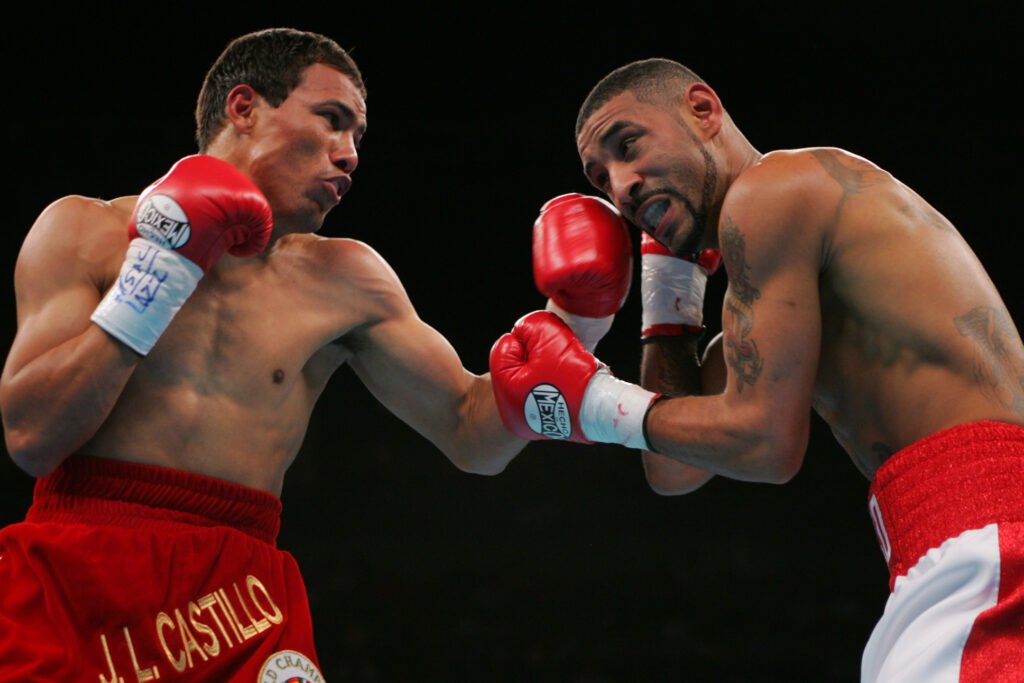
A fierce Mexican pressure fighter molded by childhood poverty, Castillo was known for aggressively stalking opponents while unleashing vicious hooks to the body and head.
Raised amidst domestic violence in Sacramento housing projects, Corrales battled early life troubles before boxing provided an outlet for the lanky brawler with speed, heart, and heavy hands. Their styles and backgrounds made it inevitable that fireworks would fly.
A Fight for the Ages
As expected, relentless exchanges erupted from the opening bell with neither fighter giving an inch at close quarters. The violent momentum see-sawed over the first half: Castillo dropped Corrales hard in round 4, but sucked up fierce return fire. By the mid rounds, Chico’s right eye closed completely as Jose focused attack upstairs.
Then came the all-time round in boxing lore. Early in the 10th, a savage Castillo left hook put Corrales down deep. Somehow he arose but soon hit the canvas again hard under assault.
With Corrales barely surviving the round by firing back, boxing had found its new gold standard for sustained drama – replete with multiple knockdowns capped by a dramatic comeback.
Legacy Continues Inspiring Fans
Incredibly, just two fights later Castillo also stopped Corrales in similarly brutal fashion. Sadly, Chico’s career was later cut short by a tragic motorcycle accident.
But for those magical three minutes where Corrales raged through pain and adversity to turn the tide, the image endures as everything heroic and great about uncompromising warriors laying it all on the line.
Castillo vs Corrales I brought sensation back at a time when boxing sorely needed a fiercely contested battle to recapture old fans while inspiring the next generation.
That memorable 10th round lives on vividly through YouTube montages and “best round” replays – renewing faith that the legends and electricity that first lured us to boxing never fade even as new stars take the mantle.
Conclusion
This guide just scratches the surface of the countless memorable fights that compose boxing’s rich tapestry in the modern era. But already one can trace the clear thematic strains and timeless appeal behind the bouts that earn enduring recognition to define their period.
Whether it’s the larger than life personae of Ali and Frazier descending from cultural icons into three legendary battles, or the stoic everyman symbolism during Joe Louis’ defining clashes, context beyond the single matchup creates resonance that lasts through ages. Other times, sheer display of will and heart – as with Castillo and Corrales waging fast-paced warfare – offer visceral appeal for all audiences.
We remember both the names themselves, and also the imagery and stories behind them that offer boxing romanticism. Dempsey charging out of his corner or Louis collapsing Schmeling define eras as perfectly as Duran’s hands of stone battering Sugar Ray.
While entire fight catalogues make up the rich fabric of the sport, a select handful of fights and rivalries stand tall enough as their own monuments. These are the bouts future generations will study and measure greatness against. And whether for sociopolitical symbolism during charged times, or strictly competitive style matchups, they never fade because boxing at its dramatic best distills something fundamentally human.
- Read More on Bleacher Report.
- Read Next on Boxing Safety and Injury Prevention: The Ultimate Guide!
FAQs
1. Who was Jack Johnson and why was he such a controversial figure?
Jack Johnson was the first African American world heavyweight boxing champion. He drew controversy in the early 1900s due to defiantly challenging racial customs and white supremacist beliefs during the Jim Crow era.
2. What does the phrase “Great White Hope” refer to in early 20th century boxing?
“Great White Hope” was a racist term applied to boxers in the early 1900s that white fight fans hoped would defeat Jack Johnson and reclaim the heavyweight title for the white race, thus restoring supposed racial dominance.
3. How many spectators attended the Jack Dempsey vs. Gene Tunney “Long Count” fight?
The famous Jack Dempsey vs Gene Tunney rematch drew a live gate record crowd of 104,943 spectators at Chicago’s Soldier Field despite heavy rain.
4. What made Joe Louis vs. Max Schmeling more than just a boxing match?
With WWII looming, Joe Louis took on heightened importance as a symbol for American democracy against the Nazi regime of Hitler that Max Schmeling represented, turning their fight into a political and cultural proxy war.
5. How did Joe Louis change perceptions of African American athletes?
Joe Louis broke through barriers as the first black sports hero embraced by white America during segregation due to his conduct outside the ring and symbolic victories against Max Schmeling before WWII shifted public opinion.
6. What made Muhammad Ali and Joe Frazier such bitter rivals inside and outside the ring?
Beyondpersonal animosity and contrasting ring styles, Ali and Frazier feuded over polar opposite sociopolitical views. Ali painted Frazier an “Uncle Tom” for not supporting his anti-Vietnam stance despite Frazier helping fund Ali during his suspension.
7. When and where did the “Fight of the Century” between Ali and Frazier take place? The legendary first fight between Muhammad Ali and Joe Frazier dubbed “The Fight of the Century” took place on March 8, 1971 at Madison Square Garden in New York City.
8. What happened in the 14th round of the “Thrilla In Manila” rubber match between Ali and Frazier?
In round 14, a battered and blinded Frazier took fierce punishment from Ali forcing Frazier’s trainer Eddie Futch to stop the brutal slugfest between rounds rather than risk his fighter taking more abuse.
9. How did Sugar Ray Leonard and Roberto Duran compare as fighters?
Sugar Ray Leonard was known for speed, athletic grace and versatility while Roberto Duran brought raw aggressive power and pressure fighting, contrasting styles that made great rivals.
10. Why did Duran utter “No Mas” in his rematch with Sugar Ray Leonard?
To this day, no one knows exactly why Roberto Duran mystifyingly surrendered in the 8th round with the words “No mas” in his rematch with Sugar Ray Leonard, whether due to frustration, being outboxed, cramps or simply uncharacteristic submission.
11. At what age did Mike Tyson become the youngest heavyweight champion ever?
Mike Tyson knocked out Trevor Berbick in 1986 to claim the WBC heavyweight title at the incredible age of just 20 years, 4 months and 22 days old.
12. How did Buster Douglas beating Tyson change perceptions of Mike’s career?
After Buster Douglas defeated Mike Tyson in 1990, exposing weaknesses in Tyson’s game for the first time, the shocking loss dented the aura of invincibility moving forward that Tyson relied upon to intimidate opponents.
13. What parallel does the Bowe vs. Holyfield trilogy have with Ali vs. Frazier?
Like Ali and Frazier decades earlier, Riddick Bowe and Evander Holyfield contested an exciting heavyweight championship trilogy defined by bitterly close decisions, contrasting styles, and controversial endings in the 1990s.
14. How did Fan Man disrupt the Bowe-Holyfield rematch?
In round 7 a hang gliding “Fan Man” sensationally flew into the outdoor arena, crashing onto the ring ropes during action and requiring several minutes to extract him – disrupting rhythm while Bowe seemed ahead, allowing Holyfield to come back after the delay.
15. What happened at the start of the Bowe-Holyfield rubber match?
The Bowe-Holyfield third fight ended abruptly when Bowe suffered a severe laceration over his eye from a clash of heads in round 3, refusing to come out for round 4 due to being ahead on the scorecards but unwilling to continue amidst the nasty cut.
16. How did Castillo vs. Corrales save boxing in 2005?
The all-action style matchup between Castillo and Corrales epitomized courageous warriors fighting pedal to the metal and recaptured attention for boxing from casual sports fans as a result of the thrilling drama.
17. What made Corrales’ 10th round comeback so legendary?
The incredible 10th round where a battered Corrales was knocked down twice early by Castillo before improbably rising to score his own knockdown late made it an instant classic round regarded by many observers as the greatest round ever fought.
18. How many times did Joe Louis and Max Schmeling fight?
The legend of Joe Louis vs Max Schmeling centered around their iconic first fight won by Schmeling and Louis’ revenge in the quicker rematch, so they fought a total of two times.
19. What happened to Diego Corrales shortly after his trilogy with Castillo?
Shortly after their classic three fight series ended, Diego Corrales tragically died in a motorcycle accident at age 29, cutting short his thrilling career at its peak.
20. How many times did Jack Dempsey fight Gene Tunney?
Jack Dempsey and Gene Tunney fought only twice but their two megafights in 1926 and 1927 became cultural events that reshaped public perceptions of boxing with Dempsey cast as the aggressor both times against Tunney’s mobility.
21. What was Jack Dempsey’s boxing style and public appeal?
With his aggressive bobbing style attacking constantly to the body before unleashing his feared left hook, Jack Dempsey ignited mainstream American interest in boxing on his way to becoming one of the sports first icons of the 20th century.
22. How many total fights were there between Muhammad Ali and Joe Frazier?
Muhammad Ali and Joe Frazier waged one of boxing’s most famous rivalries across three historic fights from 1971-1975.
23. What were some of Joe Frazier’s best weapons and tactics in the ring?
With a relentless high pressure style, Joe Frazier skillfully cut off the ring while punishing opponents with his jarring left hook, damaging overhead right, and savage liver shots on the inside.
24. Why did Bowe vs. Holyfield fail to capture the public imagination as much as Ali-Frazier?
Lacking the politically charged backdrop and magnetic personalities that sent Ali-Frazier into the cultural stratosphere, the less charismatic pairing of Bowe and Holyfield saw their ring trilogy judged more on competitive merits alone rather than as societal symbols.
25. What made the 2005 Castillo versus Corrales fight so special and memorable?
Regarded as one of the greatest fights of the modern era, Castillo vs Corrales I involved two courageous lightweights battling back and forth pedal-to-the-metal for glory, producing lots of knockdowns and heart while showcasing virtuoso two-way action in the midst of real danger.

[…] Read Next on Famous Boxing Matches and Rivalries: Defining Moments That Shaped the History of the Sport! […]